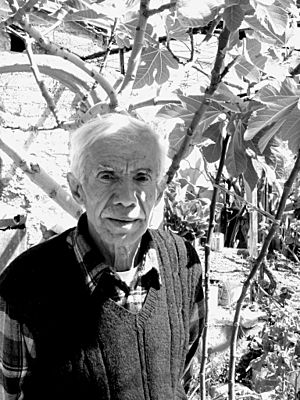Abdul Hay Mosallam Zarara facts for kids
Quick facts for kids
Abdul Hay Mosallam
|
|
|---|---|
 |
|
| Born | March 10, 1933 Al-Dawayima, Palestine
|
| Died | August 1, 2020 (aged 87) |
| Occupation | Artist |
| Years active | 1970s–2020 |
Abdul Hay Mosallam Zarara (born March 10, 1933 – died August 1, 2020) was a Palestinian artist. He taught himself how to create art. He carefully recorded the recent history of the Palestinian people through his artwork.
Mosallam was born in 1933 in Al-Dawayima, a village near Hebron in Palestine. He later lived and worked in Amman, Jordan. He painted scenes from his childhood in Palestine, especially from his village. He had to leave his home in 1948, but these memories stayed strong in his mind. He also created many artworks showing the Palestinian people's fight for their rights. His art is like a special history book, where the community tells its own story through pictures.
Contents
Life and Art Journey
Abdul Hay Mosallam never went to an art school. He developed a special art style using "painted reliefs." These artworks showed scenes from his village, like traditions and celebrations. They also showed scenes of struggle and fighting from his years living away from home.
Early Life and Work
Mosallam worked in the maintenance department for the Jordanian Air Force. In the late 1960s, he joined the Palestinian Liberation Organization (PLO). The PLO sent him and his family to Libya. While in Libya, Mosallam learned his unique art technique and started his journey as an artist.
Art Inspired by Life
Life was often hard for Mosallam and his family. They lived away from their homeland, a situation called the Palestinian diaspora. The struggle for Palestine and his active involvement in it deeply shaped his art. For many years, he had his art studio in the Palestinian area of Damascus, Syria. This area is still known as "the Yarmouh Camp." He shared his studio with another Palestinian artist, Mustafa Al Hallaj. From 1992 until he passed away in 2020, he lived and worked in Amman, Jordan.
Art in Refugee Camps
Mosallam's art truly reflected his life experiences. He created art while living in refugee camps, first in Lebanon and later in Syria. During the Siege of Beirut in 1982, he worked even under difficult conditions. He managed to hold an art exhibition right in the middle of the city's damaged areas. At that time, his art showed the feelings and needs of the people around him. Through his work, Abdul Hay helped strengthen the spirit of people fighting to survive.
Themes in His Art
His paintings show the daily life of Palestinians. You can see village weddings, Ramadan nights, and people gathering. He painted farmers and traditional dancers. These scenes are very detailed and often include traditional songs and poems. In many of Mosallam's works, women appear as a source of strength and life. They often embrace men or are shown as strong figures. This suggests the artist challenged traditional ideas about women's roles in the Arab World.
Art Technique
Mosallam used very simple tools and materials for his art. This matched his simple life as someone living away from home and fighting for his people.
Materials Used
He created his reliefs using a mix of glue and sawdust. His paintings are incredibly detailed. He sculpted even the tiniest features of bodies and faces. In 1986, a film called "Gold Dust" was made about his artworks by Mohammad Mawas. The film's title highlights the contrast. It shows how simple, inexpensive materials could be transformed into something very valuable through the artist's skill.
Artistic Importance
Abdul Hay Mosallam's artwork is like a complete record of Palestine's history and struggles. His art is well known in Arab countries. He had more than 30 solo exhibitions there. He also took part in many group exhibitions with artists from around the world.
Exhibitions Around the World
His work was shown in solo and group exhibitions. These included two in Libya (1978) and several in Damascus, Syria, between 1981 and 1991. While living in Beirut (1980-1982), one of his exhibitions happened during the 1982 siege. It was held amidst the difficult situation in west Beirut. He also had many exhibitions in Amman, Jordan, at places like Darat Al Funun and the Jordan National Gallery of Fine Arts. His art was shown in other cities too, including Tehran, Gothenburg, Helsinki, Stockholm (1983), Oslo (1981), Zurich, Bern (1990), and Houston (2003).
Recognized Art
His art was also featured in important shows. These include the "Jean Genet" show at Nottingham Contemporary (2011) and the Sharjah Biennial (2015). His work was also part of "Here and Elsewhere" at the New Museum (2014). An exhibition called "Index of Tensional and Unintentional Love of Land" also featured his art. This show was put together by Ala Younis, who worked closely with Mosallam since 2003. She helped document, organize, and digitize his artistic legacy. His artwork was also part of a Palestinian art exhibition in the U.S. at the Station Museum of Contemporary Art in Houston, Texas. This exhibition was called "Made in Palestine."
American and European art critics and journalists recognized his artistic value. They wrote about his works in various magazines. Abdul Hay had a dream of creating a museum. He wanted it to be a place not just for his own art, but for the art and hopes of his people. He also participated in an exhibition in Tokyo with 33 Japanese artists about a tragic event. Many of his artworks have been used internationally as posters, calendars, and postcards.

